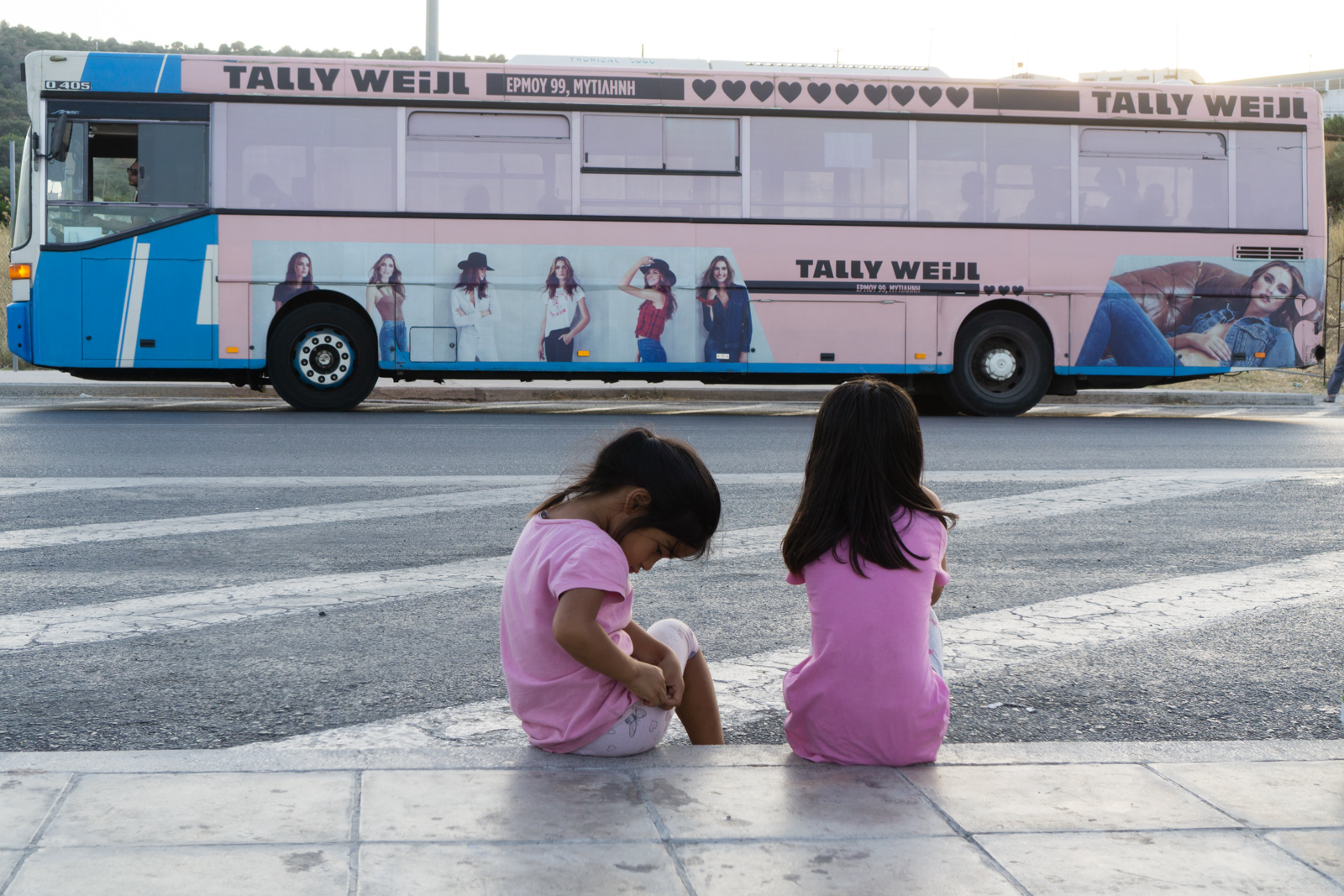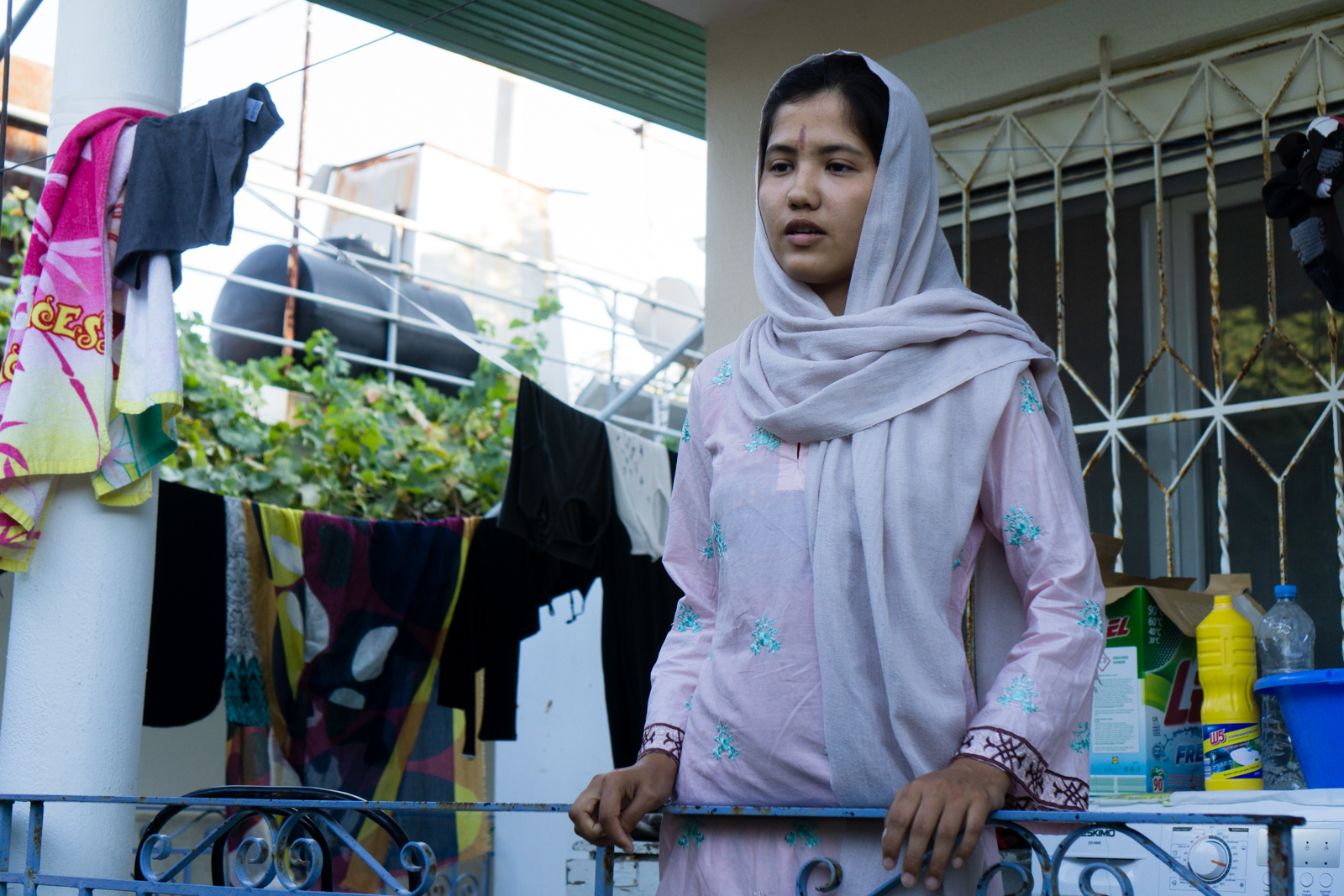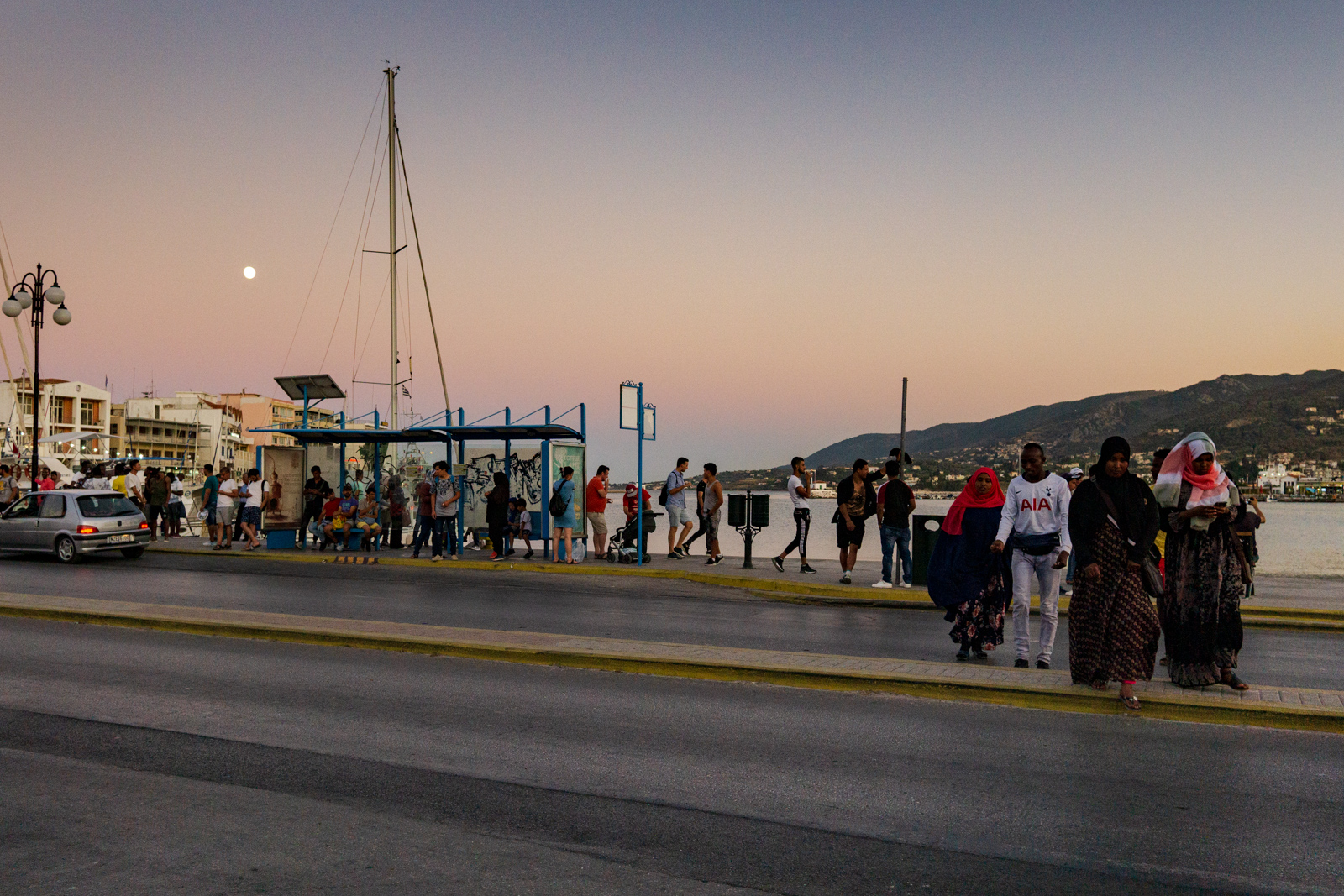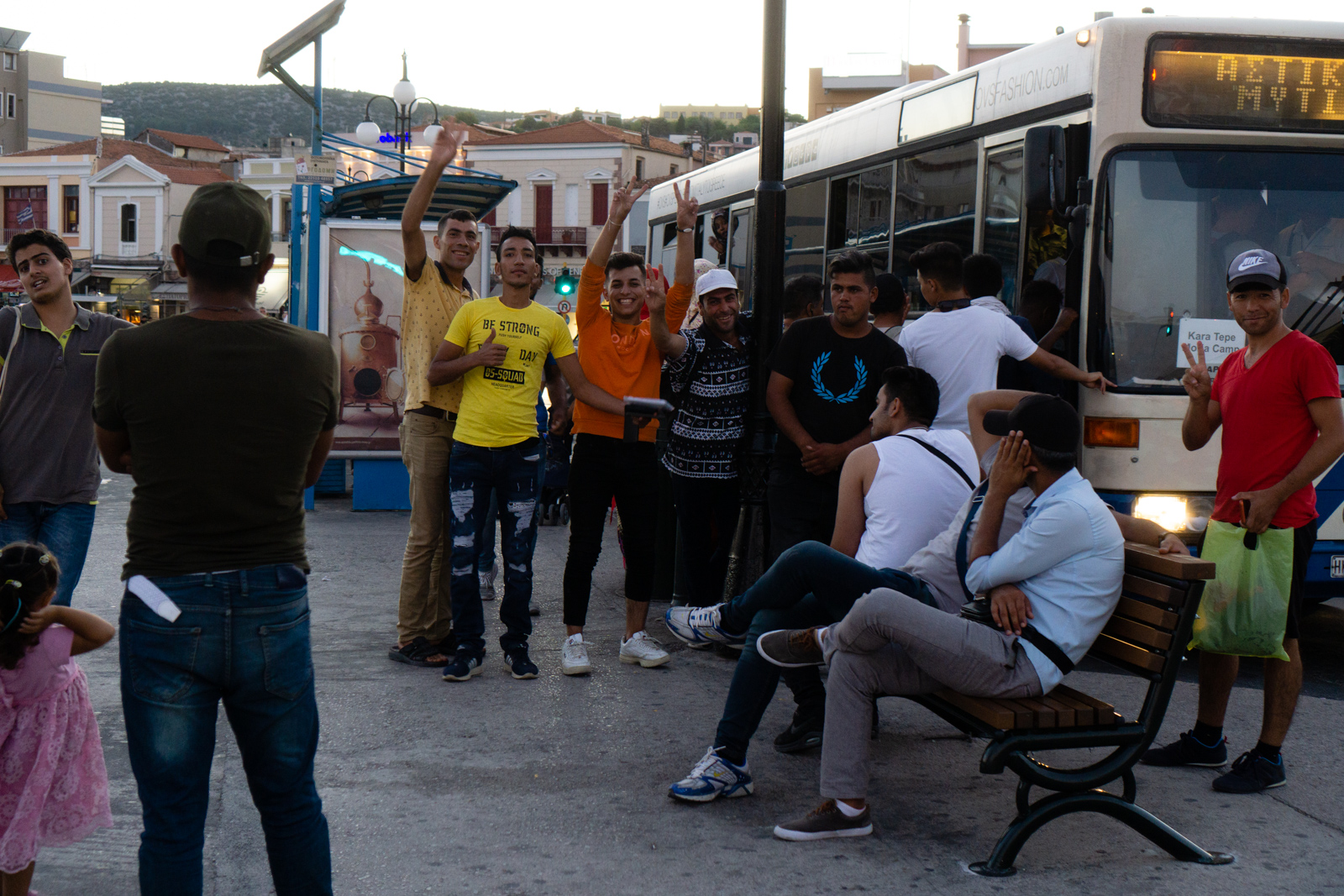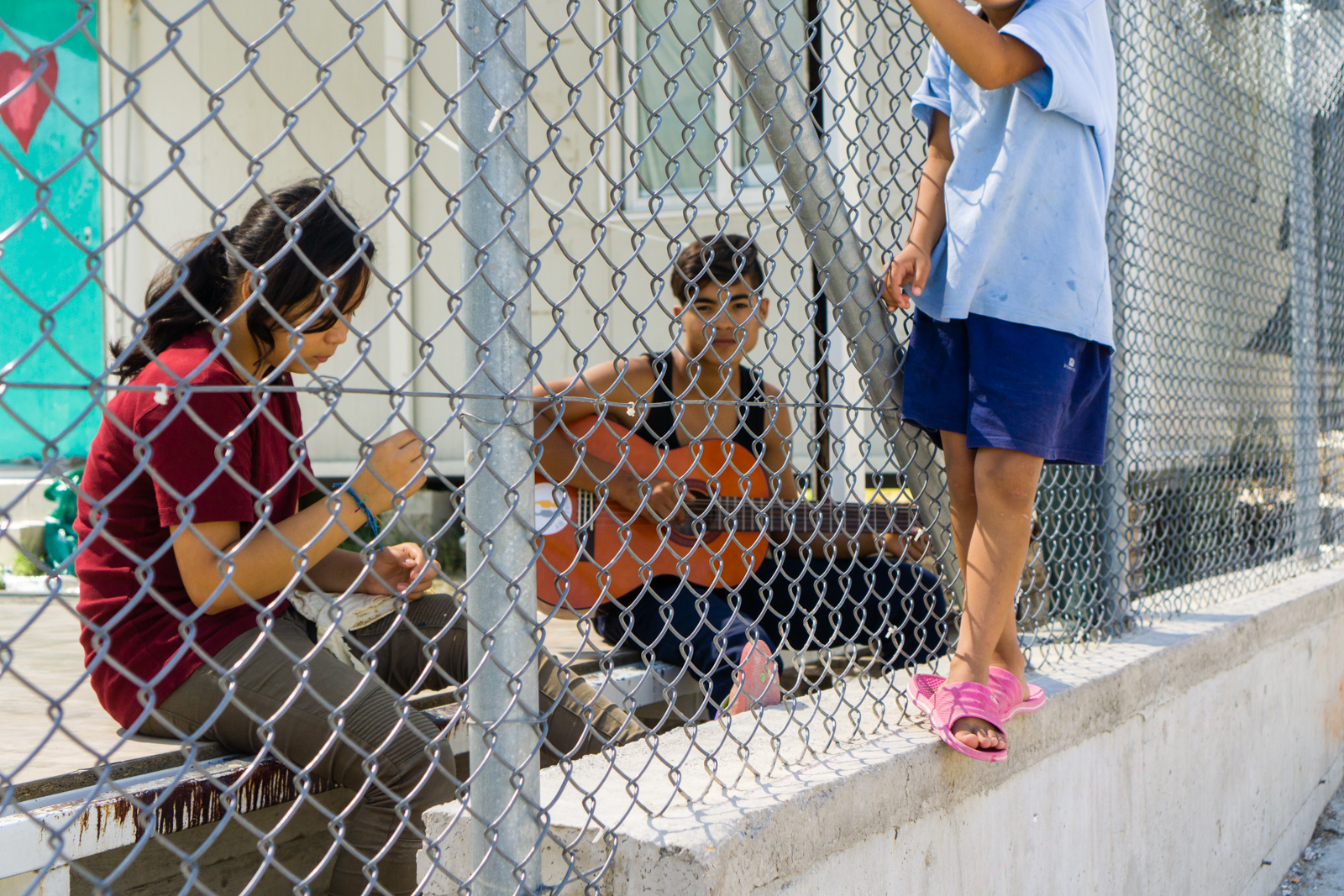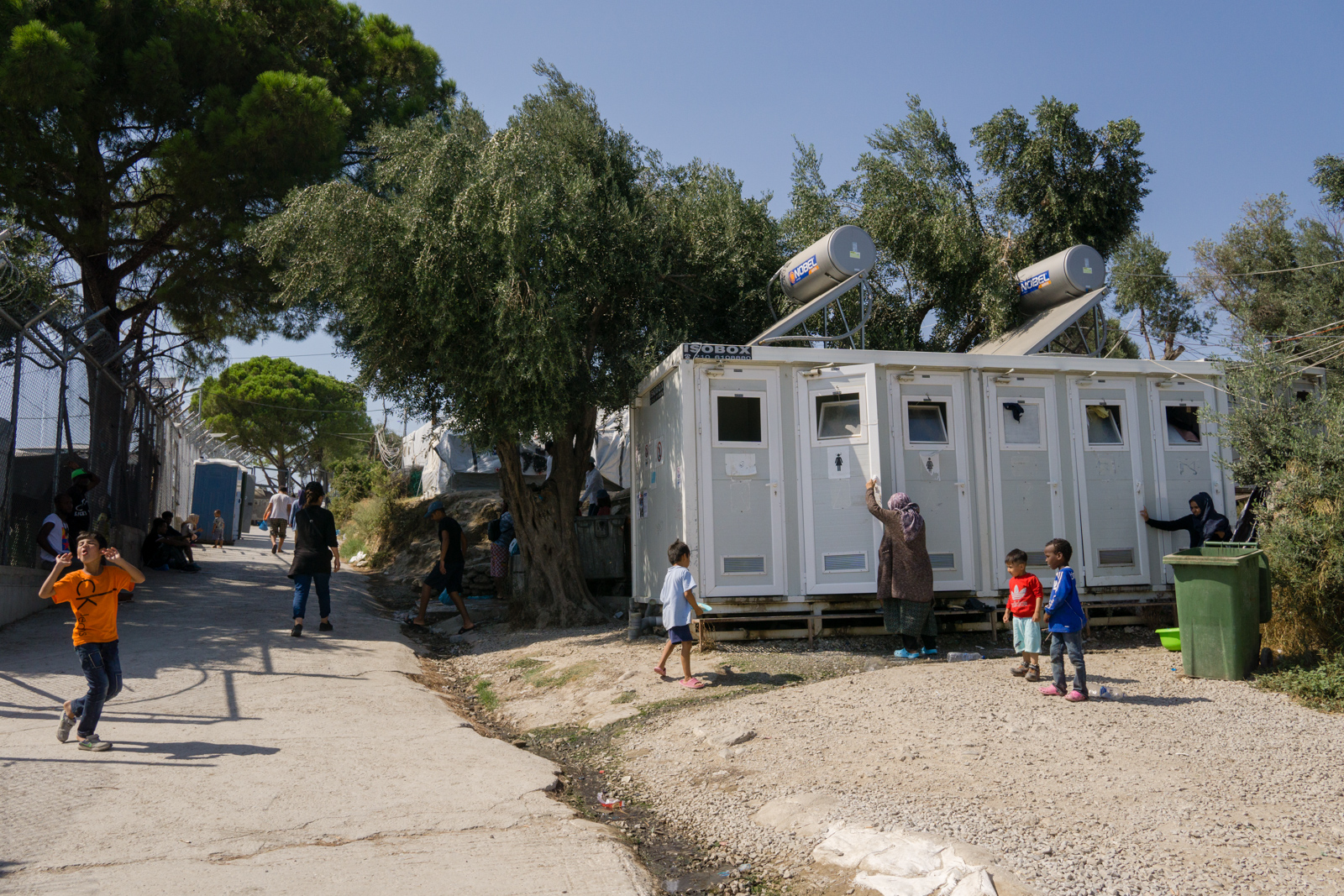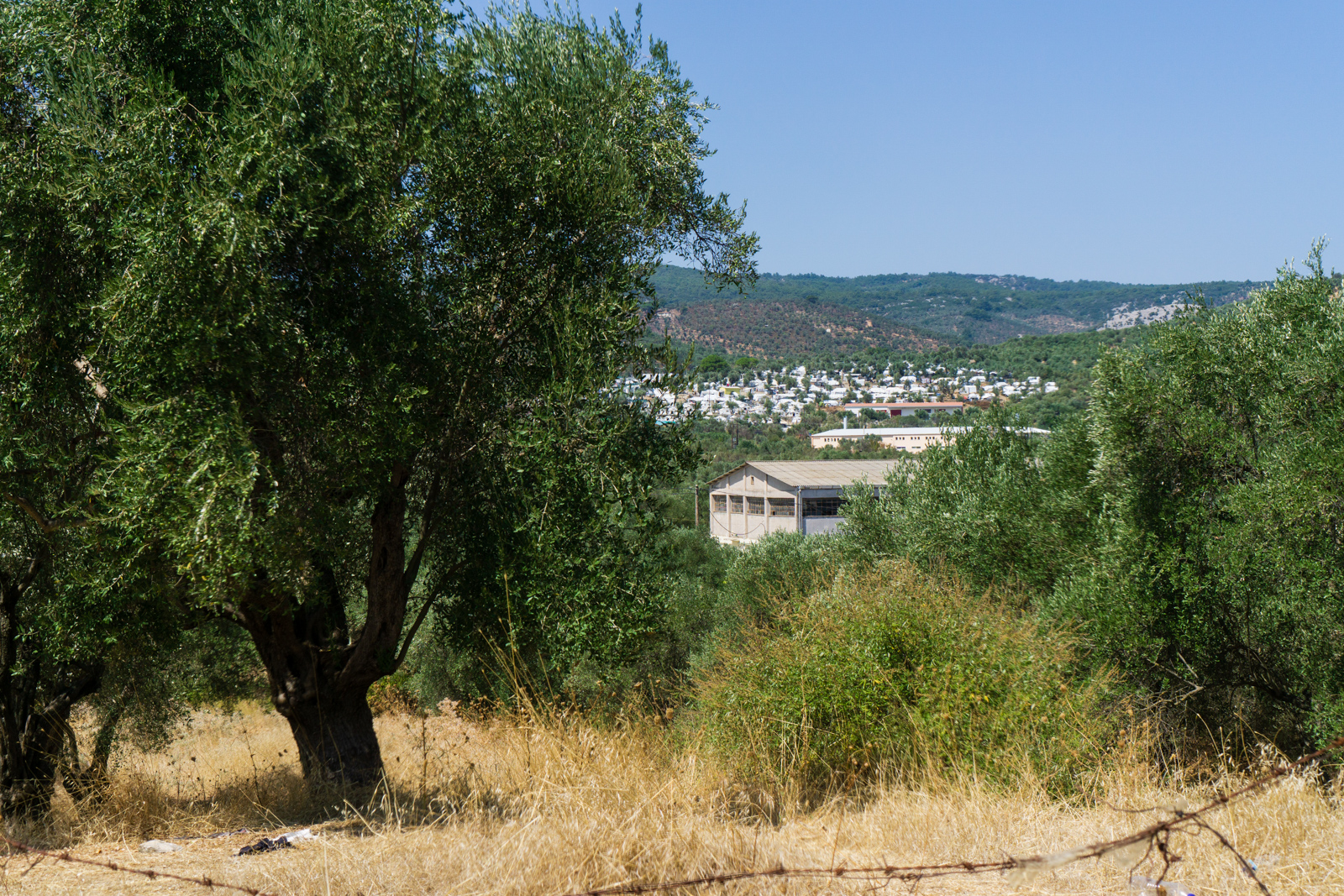A boy swims in the North Aegean Sea, somewhere between Ayvalik, Turkey and Lesvos, Greece. ©Frida Sterenberg. All Rights Reserved.
Keeping Their Heads Above Water, a Daily Drill for an Afghan Family on Lesvos
Reporting, text & images by Frida Sterenberg
©Frida Sterenberg. All Rights Reserved.
Helma and her family, Afghan asylum seekers on the Greek island of Lesvos, were finally feeling a bit of stability, having lived in the same house for nearly six months, when one day in mid-September, she received a text from their asylum case manager: they had to pack their bags and, that very day, leave the closest thing to a home they had had in two years. The family had to be at Mytilini port at 3pm. They were being transferred to Athens.
“I have just two hours to call my family and then packing stuffs,” wrote Helma in a WhatsApp exchange.
What for many asylum seekers might have been welcome news, a possible gateway to a better life in a capital city with perhaps more opportunity, for this family of six, being displaced meant a new wave of distress. Because on Lesvos, against all odds, each family member had established for themselves the kind of rhythms and routines that make up a life, even as they knew it would be temporary. By early 2020, things were bound to change one way or another: the Greek Asylum Service was scheduled to hear their request for asylum and would then decide whether they could stay in Greece, move on to northern Europe, or be deported out of the EU. But the normalcy they had found in Lesvos was – for the time being – welcome. However, for a refugee, stability is nothing but a tenuous concept, as deceptive as the calmer waters of the Aegean Sea in summer.
The illusive nature of stability is something Helma has known her entire life.
Helma and her sisters Asiye, 18, Sami, 22, and Negin, 13; their brother, Ali, 16; and their mother, Raziye (all names were changed to protect their identity) are Afghans of the Hazara ethnic group. Like most Hazara, they are Shia Muslims. The Hazara have been a persecuted minority in Afghanistan since the late 19th century. More recently, during the Taliban regime, the Hazaras were specifically targeted because the Taliban considers them infidels.
Raziye and her deceased husband had left Kabul for Arak, Iran long before the Taliban came to power in 1996. They fled after the Soviet invasion in December 1979, when their house was bombed. The revolution in neighboring Iran had brought to power Ayatollah Khomeini, who welcomed Afghans running from the violence at home.
“He said: ‘Open the borders, we’re all Muslims,’” Raziye recounted in Farsi with her daughter translating to English.
She and her husband eventually settled in Qom, Iran where they received asylum. Raziye’s children have never been to Afghanistan. They were born and raised in Iran and were always refugees there. As Afghan refugees, they would never acquire Iranian citizenship, were forbidden to travel to most parts of Iran, and access to university was virtually impossible.
Although considered Afghan nationals because of their father’s identity card (the tazkira), they weren’t able to acquire Afghan passports. The parents, a construction worker and a carpet weaver, could not afford trips to Afghanistan to claim citizenship for each of their children. It would be more expensive than to keep renewing the asylum cards in Iran, Asiye said.
That’s how for Raziye it’s been forty years as a refugee, and for her children a lifetime.
Asiye plays an Afghan folk song and translates its lyrics. Her mom, Raziye, sits by her side in what was briefly their home on Lesvos. ©Frida Sterenberg. All Rights Reserved.
“We did not live like humans there,” Asiye said. “We had to work all the time, no vacation even for Nowruz [Persian New Year].”
They saw no prospects of a better life. And they all want an education.
With the difficulties to keep up her family, Raziye was being pressured by her husband’s brother to marry her daughters to his sons (their first cousins).
“He always wanted to marry my sisters to his boys, and we didn’t want this to happen. If we stayed my mother would have to [accept it],” Asiye said.
In 2017, the family decided to leave Iran, but didn’t see Afghanistan as a possible home. They had nothing to go back to. No immediate relatives, no house, no prospects in a war-torn country.
According to the Global Peace Index 2019 by the Institute of Economics & Peace, Afghanistan is the least peaceful country in the world among 163 countries. More than 100,000 civilians were killed in the last 10 years alone in Afghanistan, says a recent UN report. And because Hazaras are considered infidels by the Taliban, there is no guarantee that any peace negotiations with the group – like the recent talks by the Trump administration – might not be broken off suddenly and the Hazaras become direct targets of persecution again.
More than 6 million people are estimated to have fled Afghanistan since the Soviet invasion in 1979. They are scattered across more than 75 countries with the great majority located in neighboring Iran (almost one million) and Pakistan (1.5 million). Two million more are estimated to be in these two countries but remain undocumented, according to the United Nations High Commissioner for Refugees (UNHCR).
Afghans make up the second largest population of refugees in the UNHCR system. (Palestinians are a larger group but are monitored by a different UN agency.) Afghans had been the largest group for almost forty years until 2015, when the huge Syrian refugee population fleeing the war and the Assad regime outnumbered them.
Years of endless wars – the Soviet invasion, a civil war, the Taliban regime, the US-led invasion, the Taliban’s will to return to power and its friction with a small but growing presence of the Islamic State (ISIS in Afghanistan) – have caused economic collapse, internal displacements, and mass exodus. Combined with deportations by host countries, especially from Iran and Pakistan, these events have put the Afghan population in constant flux.
Generations of Afghans are going their entire lifetime without a sense of place or belonging, stripped of civic participation and representation.
Helma and her siblings are trying to escape this bleak reality. Having gone through hardships and discrimination in Iran for being Afghan refugees, and with the prospect of facing persecution and more insecurity in Afghanistan for being Hazaras in a perpetually unstable country, the family is determined they can only find a home and thrive somewhere else.
In July 2017, they set out from Iran, hoping to reach Europe via Turkey. Sixteen months later, in November 2018, they made it finally to Lesvos, Greece, requesting asylum at the Moria reception and identification center.
When asked which country she would like to go to, Helma said it doesn’t matter.
“Just one country that I can continue education and find a job. The simple life.”
Helma and Asiye wait for a bus to go home; two little girls wait for the bus to Moria refugee camp; Asiye at the porch of her home in Thermi; three young Afghans on their way back to Moria; young asylum seekers wave peace signs; people try to squeeze in the bus to the refugee camps; the bus stop opposite Sappho Square; two Afghan men talk and try to catch fish. ©Frida Sterenberg. All Rights Reserved.
As of Dec. 30, over 40,000 migrants are stranded on the Greek islands closest to the Turkish coast. Half are on Lesvos. A new conservative Greek government that took power in July 2019, under pressure to address the inhumane conditions at the islands’ reception centers and refugee camps, has promised to move 20,000 people to the mainland by early 2020. Moving Helma and her family to Athens was part of this policy. The government also announced plans to close the largest refugee camps on Lesvos, Chios, and Samos, and substitute them for new, smaller detention centers that will contain the refugees until they are either granted asylum or are deported to Turkey or to their countries of origin. Human rights groups and NGOs have denounced these plans as further endangering the lives of refugees and as violations of their human rights.
During a phone interview in early October, Asiye, 18, spoke about the family’s sudden transfer and the need to comply.
“Because island is full of refugees, they said ‘you have to go, it’s not your choice. If you don’t want to go you have to go to Moria.’”
For the family, this was out of the question. Moria, the largest European refugee camp, is facing nothing less than “an emergency situation,” according to Ihab Abassi, project coordinator assistant at Médecins Sans Frontières Lesvos (MSF). In the summer, the international organization was already warning that living conditions in the camp were abysmal, and that the growing sense of uncertainty – coupled with traumas people suffered before, during, and after their journeys in search of a safe haven – were causing severe psychological damage.
“We’re dealing with a whole traumatized population. No exceptions,” said Abassi.
Even young children are attempting to harm themselves, said Athanasios Paraschis, a psychologist with the MSF clinic outside Moria.
In August 2019, there were about 9,000 people in Moria. The camp was designed to hold 3,100. Unable to fit within the barbed-wire perimeter of the official site, an old army base, newcomers pitch tents on the surrounding olive groves, an area known to all as “the jungle.” The jungle is considered dangerous because Greek police offer no protection outside the official site and cases of violence have happened there. NGO workers, by contract, are not allowed to go in the jungle due to lack of security. Still, it is where new mothers with infants, recent arrivals on the island seeking asylum, are being installed.
By December 2019, the number of people in Moria had doubled. More than 19,000 people are estimated to be in the camp now, exceeding its capacity by more than six times. People wait three to four hours in line every day to receive food, hundreds do not get any. Overcrowding, lack of basic sanitary conditions, despair, and violence is what children, many unaccompanied minors, and adults of all ages have been exposed to month after month, for time undetermined. Women and girls are particularly vulnerable in these unsafe conditions.
“In Moria, families like us, [who] don’t have any men, they are only girls, they don’t have safety,” Asiye said.
2019 marked the highest peak of sea and land arrivals on the Eastern Aegean Islands since the crisis of 2015, when almost a million migrants, mostly Syrians escaping the war, crossed from Turkey to the islands and moved on to Europe. Although the number of arrivals is not comparable to 2015, since the EU-Turkey Deal, the migrants have been stranded on the Aegean Islands waiting for their asylum requests to be processed. The procedure is slow and, in most cases, takes years to resolve. Any balance between arrivals and departures to/from the islands is long lost. In Greece, the heavy weight of dealing with an ever-increasing migrant population trying to reach Europe has mostly fallen on the islands closest to Turkey, of which Lesvos is the largest.
Moria’s population of asylum seekers has doubled from August to December 2019. More than 19,000 people are living in squalid conditions, without proper care, lacking basic sanitary conditions, and where violence often erupts. Women and girls are particularly vulnerable in this environment. ©Frida Sterenberg. All Rights Reserved.
Latsoudi’s hope rests on non-governmental groups and civil society. “There is a really strong solidarity movement, there are people that stand in solidarity with refugees all over Europe and in Greece, and I believe this can make the difference.” Efi Latsoudi
According to Helma, she and her brother Ali boarded a bus from Qom to Tehran on July 23, 2017. They met their older sister and her 10-year-old child and continued the trip together. Their smuggler sent a car to take them to the Turkish border. When it got dark, they moved by foot, crossing the border “secretly, without the light and without any noise,” she said. Someone met them on the other side, in Turkey, and they continued walking until they arrived at a village where they rested for a few hours. They had walked for six hours. The smuggler sent a car to take them to Van, a city in East Turkey close to the Iranian border.
They spent one month in Van until they were able to go to the UN office in Ankara, in the center of Turkey. The UN office provided them with “a paper, a permission,” said Helma. It is an ID document (kimlik, in Turkish) that gives international protection and the right to stay temporarily in Turkey as long as the applicant remains in the satellite-city appointed to them and signs-in regularly (once a week, according to Helma). They were given three choices: Kayseri (center), Elazığ (east), and Trabzon (northeast).
“We say we don’t know anything about the cities, and how we can go without any language, without any house for living? [So,] they chose Elazığ for us because it’s cheaper than the other cities.”
Helma said they got some money from the UN office to travel to Elazığ. And for one week they slept on the streets and in a park.
“Because it was very difficult to understand people and know which part of the city is cheaper [to rent a house].”
They learned to navigate the new environment by going often to the governor’s office, where people need to sign-in every week, and asking help from other refugees. They rented a place and Helma found some work “for a little money” helping a local Afghan tailor. Their neighbors helped Helma and Ali register for school. Helma said mathematics, physics, and Koran were not difficult for them to follow, but literature in Turkish posed a real challenge for both of them. Still, they were in school. They spent a total of nine months in Elazığ, and Helma and Ali were able to pick-up some Turkish during that time. Raziye, Sami, Asiye, and Negin arrived in Elazığ about six months later.
Helma said trying to resettle in Turkey would be too difficult for them because they want to continue their studies and go to university. They were restricted to Elazığ, with constant sign-ins and finding legal work for a decent salary would be challenging. Even if they wanted, permanent settlement in Turkey may take years to get and, now, for non-Syrians it is very difficult to obtain. They decided to move on.
They found a new smuggler to take them from Turkey to Greece and in September they moved to “the smuggler’s house” in Zeytinburnu, a neighborhood of Istanbul. The family tried the Aegean Sea crossing twice, with no success. According to Helma, they spent a total of two months there between the failed attempts and the wait for adequate weather conditions to take to the sea again.
Their second attempt took place in October. The smuggler sent a dolmuş, a big van normally used for passenger transportation. All the seats were removed. Fifty people entered the van; older people sat while younger people stood. Asiye was one of the people standing. She said she stood for 10 hours. They were heading in the direction of Aydin, a city south of Izmir, closest to the Greek island of Samos.
“After three hours we couldn’t breathe,” she said, but the driver wouldn’t stop. Asiye recalled removing a rubber piece from the corner of the door frame to allow air inside the van.
Asiye was standing in front of the only window in the back of the van. She said a police car started to follow them, and she watched as the police started to shoot at the van. They shot at the wheels and the van almost lost balance but came to a stop. The driver ran away into the woods and they could smell smoke. The police were afraid to approach the vehicle and the people inside the van were afraid to get out, but babies were crying so they opened the doors. Asiye said the officers, who counted as each person stepped out of the van, were shocked at how many people were inside the vehicle. They were taken to a “special camp,” according to Helma, close to Aydin where they remained for two nights. (This report can confirm that there is an Aydin Removal Center where refugees are detained and sometimes deported from.) After they were released, they went to the bus terminal in Aydin and, once again, bought tickets back to the smuggler’s house, in Zeytinburnu.
On the third time they finally succeeded. From a beach somewhere close to Izmir, their experience was as stressful, intense, and as dangerous as any other account one hears from refugees who travel by sea in small, inflatable rafts: with no money left, they had to borrow to buy life jackets. They were about 30 people. The women waited in a field, in the cold, while the men in the group had to fix the dinghy. The smuggler rushed them to embark and, in the dark, they were calling each other’s names to make sure the whole family was in. Once at sea, somewhere between Izmir, Turkey and Lesvos, Greece, this is how Asiye recalls the crossing:
“I was watching the sky because everywhere was dark and very, very silent. And the light was just from the stars. My head was up. And I was thinking about my life. And I really didn’t care. That moment I really didn’t care about my life. About my future. And I was just thinking: ‘Maybe this is the last moment of my life.’ And it was very, very relaxing. Good. I was saying ‘Helma, Helma, watch the stars. It’s very beautiful.’ And until the end, there was a boy, and he was all the time saying very, very whispering:‘I know, I know we reach. This time, I know we reach.’”
AsiyeThe Aegean Sea Crossing
Listen to Asiye’s account of the family’s crossing of the North Aegean Sea, from Turkey to Greece. ©Frida Sterenberg. All Rights Reserved.
When the family disembarked from the dinghy, on November 2018, they burned their life jackets to dry and warm themselves, and to attract the attention of authorities. To no avail. They finally walked away from the beach and asked a pharmacist in a drugstore to call the police.
Misinformation, fear and confusion are common at every step of the way for asylum seekers who successfully make the crossing to Europe after exhausting and dangerous journeys. It is particularly so at the “hotspots,” the reception and identification centers such as Moria. People already living in the camp yell confused messages to newcomers, among them to tell authorities they are minors, or the opposite, to say they are adults. Sometimes that’s because UNHCR cash assistance for adults is €90 per month and for minors is €50. Other times, it’s because unaccompanied minors are supposed to be treated with special attention. At the end of 2019, 34% of the population of refugees and migrants on the Aegean Islands were children, of which about half are unaccompanied minors. Most of the solo children are Afghans.
At the identification center in Moria, Helma said she was 19 years old. In fact, Helma is 26. Her reason to say she was younger was because she wanted to make sure her asylum request was processed together with her family’s and not as a separate adult. It didn’t work, though. Her asylum interview is due to happen a couple months after the rest of her family because 19 is considered an adult.
The family went through their first Greek winter in Moria refugee camp. In the beginning, they lived in tents, then they were moved to a shipping container. By that time, their older sister and her 10-year-old child had already been transferred to mainland Greece.
In the container, the space was divided in three, and they shared it with two couples. In their part, they were six, and there were only two beds.
“One of us should almost sit so another can lay down,” said Asiye.
After witnessing a fight take place in front of them in which a man got stabbed, Asiye said her mother could not sleep at night anymore.
In addition, Raziye, the mother, suffered from a gastric ailment that they didn’t receive a specific diagnosis for, but she could not eat the food in Moria.
“We went to the doctor, and [he] wrote to his boss in Moria ‘They must go to another place so she can cook special food for herself,’” said Helma.
Then, the youngest sibling, Negin, 13, developed a skin disease. A doctor told them it might have been caused by bedbugs. There were bedbugs in the smuggler’s house in Turkey. The girl’s back and head were covered with abscesses. That’s when the family was finally considered for a change of lodging.
In early spring, they moved to a house in Thermi, 7.5 miles from the capital Mytilini, which they shared with another vulnerable family.
On an August summer evening, Helma was sitting on a bench opposite Sappho Square, in Mytilini. She watched as people, including families with small children, squeezed into a bus with a sign on its front window that read, “Moria — Kara Tepe.” Inside, the bus was full; outside a chaotic situation ensued. Those unable to board expressed their frustrations loudly. This happened every evening in the summer at around dusk, a reflection of the ever-increasing numbers of migrants and asylum seekers dwelling at these refugee camps on Lesvos.
Helma knew the drill well; having lived in Moria for four months during the winter, she could empathize with the stressful atmosphere at the bus stop.
“When we came to this island it was very, very cold. First, we lived in the tents, under the rain and the cold weather,” she recalled. Helma has a soft tone of voice; she spoke in English, and asked questions whenever she got stuck finding the right words.
But that summer evening, tired from a day of working as a gardener, Helma just felt relieved that she was not going back to Moria. She was waiting for the local bus to Thermi to return to a place she could briefly call home.
That’s why compared to many other asylum seekers on Lesvos, Helma’s family might have seemed to have found a trace of stability. Even comfort.
In August, their family of six was living in a small house in Thermi. They had moved there in the spring and shared the lodging with another Afghan family. They expected their asylum interview to take place in early 2020. Three of the siblings had found jobs with NGOs that paid little but provided helpful income. On the weekends, Helma and Asiye were sewing bags to sell through a co-op they helped create. The house had a kitchen stove, which meant their mother could cook for the family and even bake breads to sell. The sense of relief was such that Helma’s sister, Sami, decided to remove her hijab altogether after moving into the house. She said she felt safe.
“I felt peace when we moved here,” said Raziye, in Farsi, with her daughter Asiye translating.
Their place was half a mile from the main road leading to Thermi, a village 30 minutes by bus from Mytilini. On a walk there, one is immersed in a bucolic scenery filled by houses, olive trees, goats grazing on one side of the small road, and a cow and a chicken minding their businesses on the other side. Helma liked to live close to nature and to see animals around. A pomegranate tree full of fruit stood at the curve right before their house. In their home’s front yard, Helma and her mother planted a small garden where they were harvesting cherry tomatoes, eggplants, and cucumbers. There were also sunflowers and roses.
Helma prepared a jar of sweet mint lemonade with ice, a treat for a hot summer day. The hum of a washer provided some white noise, and clothes were hanging outside in the porch.
The house was provided by UNHCR through ESTIA, the Emergency Support to Integration and Accommodation program, which provides almost 26,000 urban accommodations and cash assistance to refugees in Greece. Most accommodations are reserved for families like them, with more than five people and some attested vulnerability condition.
Theirs was small and comfortable. Their part had two rooms furnished with bunk beds and single beds. The kitchen had a stove, and Raziye was able to cook for herself, the family, and to bake loafs of bread to sell to refugees that pre-ordered them in Moria camp. The other family lived, separately, upstairs.
Asiye started to strum a melody in a guitar. She said she really wanted to learn the piano but the impracticality of it made her decide to take guitar lessons at One Happy Family (OHF), a Swiss-based NGO operating on Lesvos since 2017. She likes to play folk Afghan music and rock & roll.
They started to frequent OHF while they were still in Moria. Their mother wanted them to stay away from the camp as much as possible during the day to avoid the stress, the dangers and the idleness inside.
When Helma started going to OHF she found a new interest. She joined a group of young people learning photography and film with the NGO ReFocus Media Labs. In the summer they were working on the production of a short film based on the experiences of refugees. She says that is what she would like to continue to do wherever she settles in the future.
Asiye and Helma are good seamstresses. They started to create bags out of recycled jeans that didn’t fit them. They make shoulder bags and knapsacks, some of them ornate with colorful embroidered designs. Inés Marco, coordinator at Women in Solidarity House (WISH) at OHF, recognized their talent and drive, and created with them a workshop in an improvised shack a couple steps down the hill from the one room known to all as “the women’s space,” where women can congregate in a safe place.
The family was focusing on creating a better life for themselves, improving their skills, going to school, learning English, being entrepreneurial, and trying to save money while waiting for their asylum interview scheduled for early 2020.
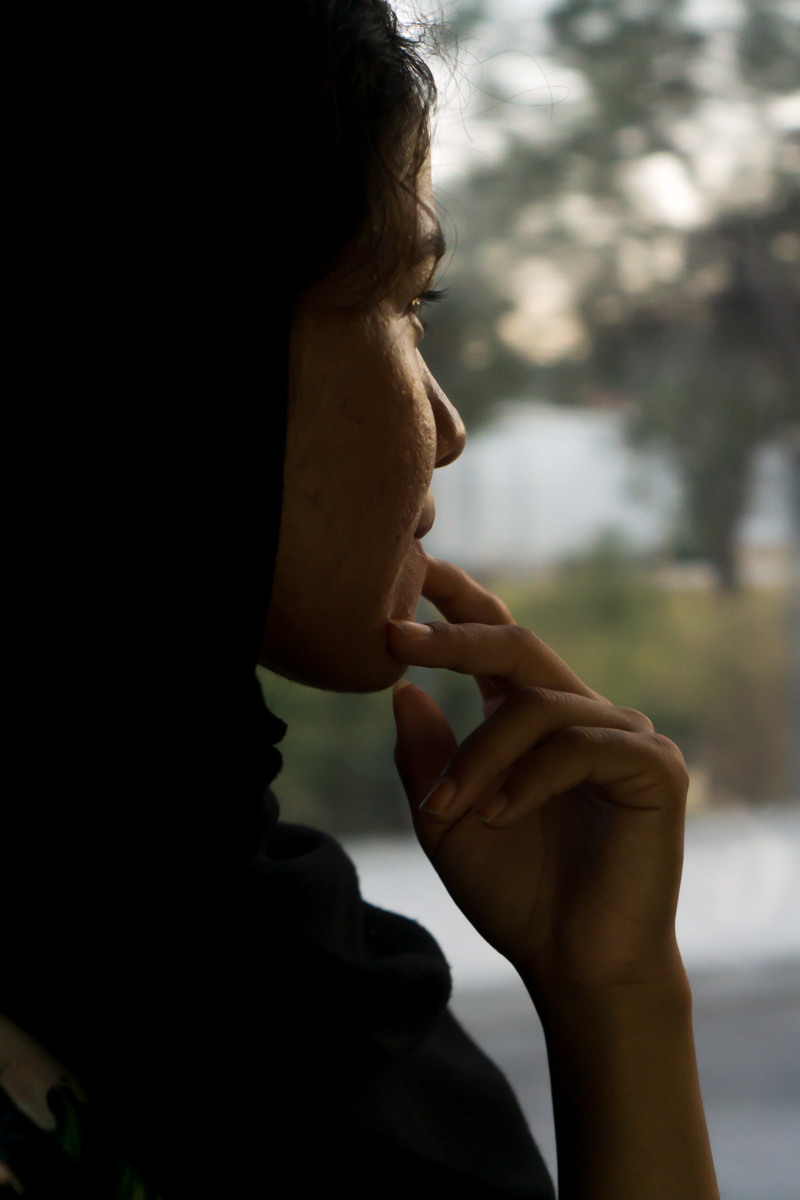
Helma dreams of going to university. In the past, she said, she thought of studying “the stars and the sky, Astronomy.” She’s proud to have been on top of her high school class in Mathematics. Now she is involved with photography and video.
Helma took photographs in Moria camp, hiding a camera inside her clothes. She had to run away from a police officer and was ordered to delete the files, but she did not. A Spanish newspaper published a couple photos under a pseudonym because photographing inside Moria is prohibited without permission. Helma now knows that’s what she wants to dedicate herself to. Over the summer, she and a group of young asylum seekers shot a short movie based on the experiences of refugees going through the dangerous journey between Turkey and Greece. The group participates in workshops with Douglas Herman, co-founder of ReFocus Media Labs, a non-profit that operates inside One Happy Family Community Center (OHF), a Swiss-based NGO, operating on Lesvos since 2017.
In the summer, Helma was working as a gardener at OHF and learned permaculture. For that, she received a credit of up to €200 per month that she could use to buy essentials and be reimbursed after showing the receipts.
In December, she found a job with Safe Passages at Mosaik Support Center, a Greek NGO that promotes integration among the local community and the new communities of refugees. The work helps refugees and asylum seekers increase their self-sufficiency. Helma
Asiye is learning to play the guitar. She likes to play Afghan folk music and rock and roll. She wants to learn electric guitar.
Her life experiences have given her inspiration for what she would like to do in the future.
“I saw people in Moria, they had many problems. And also, my mother [have problems]. So, I think in future, if I be a doctor, I can help people with what they need.”
Asiye knows she has no control about if and where her family will get asylum but when asked to which country she would like to settle, she said:
“I don’t know, maybe Canada. It’s far away. Now we don’t have a choice for country. We are just waiting for, maybe, a miracle.” Asiye

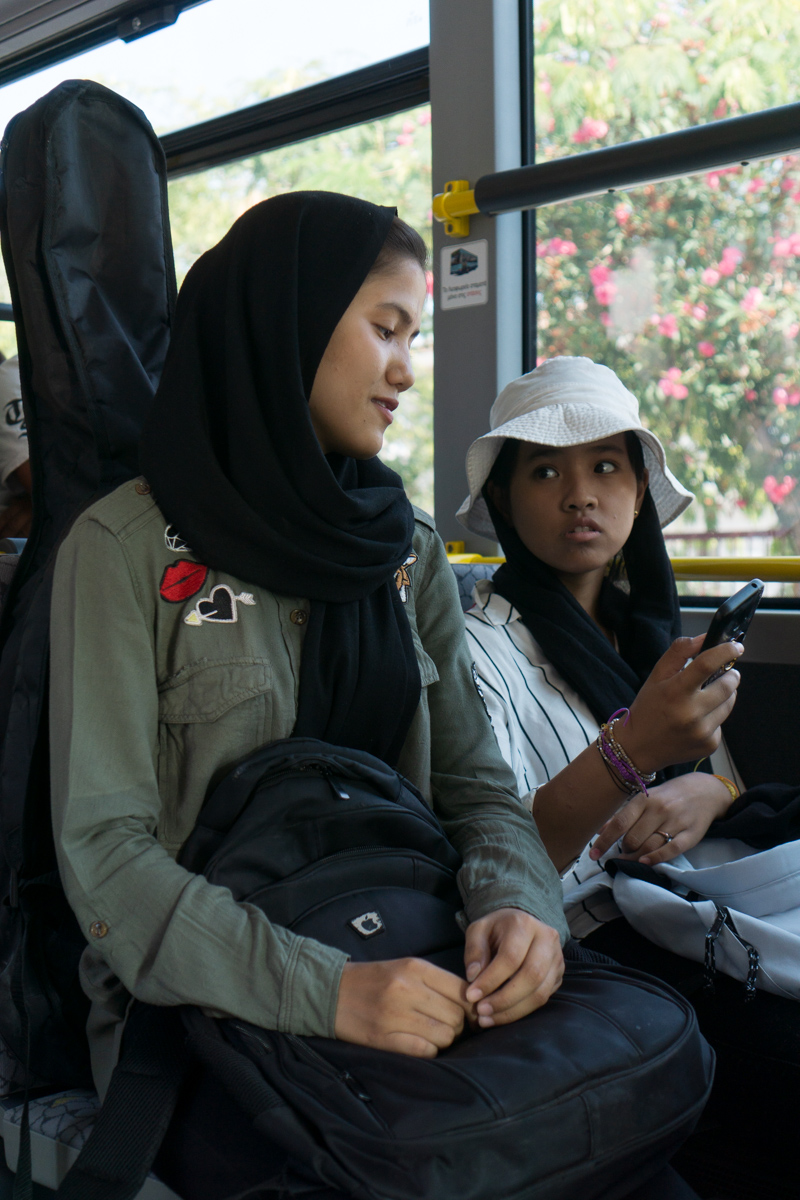
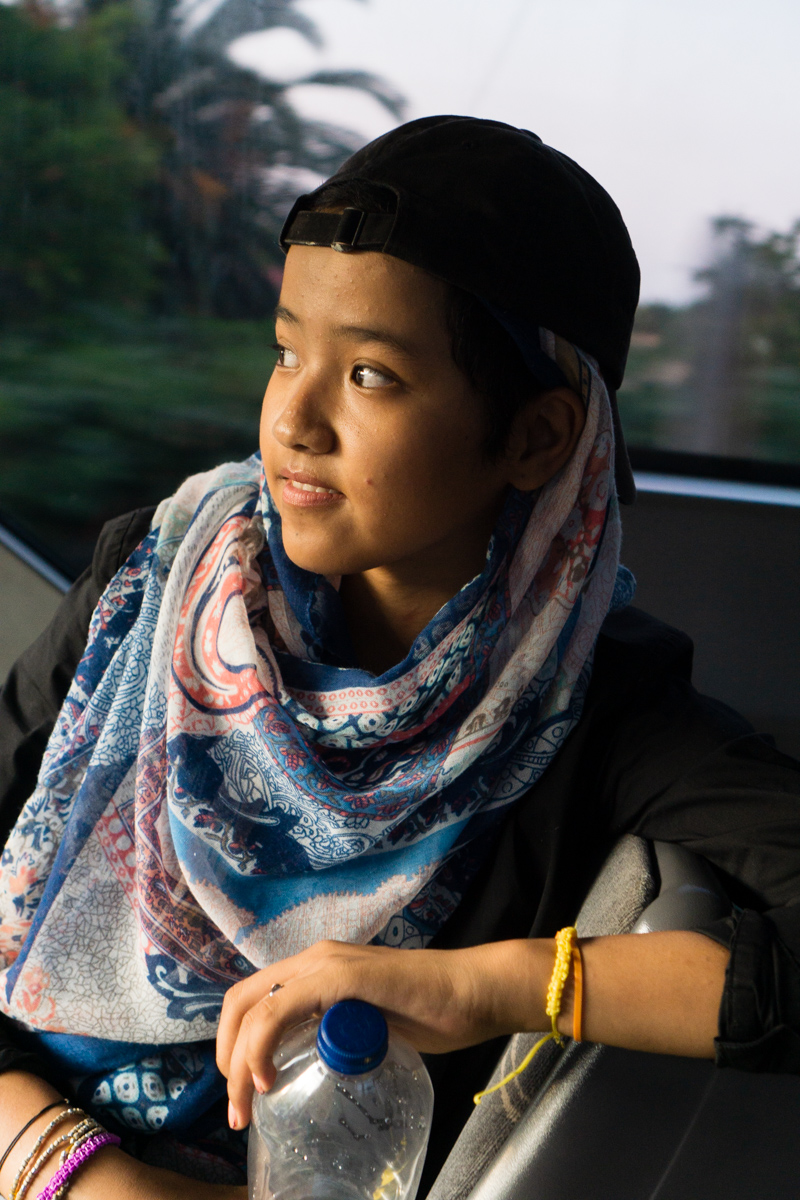
“They are all kids and, you know, smiling and laughing and be[ing] happy. I like it like this,” Sami said on a phone interview making an effort to express herself in English. She hopes, one day in the future, to be able to go to Afghanistan and help people there who “do not have a good life” and safety.
Sami is the only one of the five women in the family who does not cover her head. She said the moment she entered the house in Thermi, she decided not to wear a hijab anymore. Sami said she felt safe. Sami
Helma and Asiye in their temporary home in Thermi where they had found a short-lived sense of stability. ©Frida Sterenberg. All Rights Reserved.
When they got the call in mid-September that would take it all away, they had no choice but to pack in a hurry and abandon their hard-won tranquility and emerging entrepreneurship. And in Athens, they were given a home full of problems.
According to Asiye, the house was very dirty and small, but they said it was OK. They cleaned the house and a water pipe broke. There was a lot of water on the floor. Raziye wanted to cook, then a fuse went off. They called someone to fix it and were told not to use the stove, which meant they could not cook. For the pipes and other issues, they were told someone would return the next day, but no one showed up, she said.
Even worse, there were bedbugs.
“We were very confused, very disappointed, we didn’t sleep for two nights. We were walking around the streets until morning. We were worried about our sister. My mom was concerned about her sickness [returning],” said Asiye.
They asked to be moved to a different place and were given an apartment that was in even worse shape, they said. But that was not the problem. The neighbors were the problem. They didn’t want to let them in the building.
“They were screaming ‘We don’t want refugees; we will call the police,” said Asiye.
They were only able to enter the apartment with an UNHCR person escorting them. But they didn’t feel safe in the neighborhood, and moving a third time was not an option. The new reality was too daunting. They felt an urge to return to Lesvos. They wanted to give back the keys of the apartment on the spot to the UNHCR person.
“They said if you don’t take the keys, your money will stop. So, we took the keys and bought tickets back to Lesvos,” said Asiye.
Expressions of racism and xenophobia against refugees are increasing in Europe in general and in Greece, in particular, after the far-right Golden Dawn Party found space to grow in the last round of elections.
“I think that refugees’ issue, like everywhere in the world, is very much used and exploited by the right wing and the far-right wing. They create fear to the people, and they create xenophobia so the enemy is there, and the only thing that we have to do is get rid of refugees and ignore the whole complexity of the issue, the complexity of the refugee flows, and the reasons why people flee their countries,” said Efi Latsoudi, co-founder of Lesvos Solidarity and Mosaik Support Center.
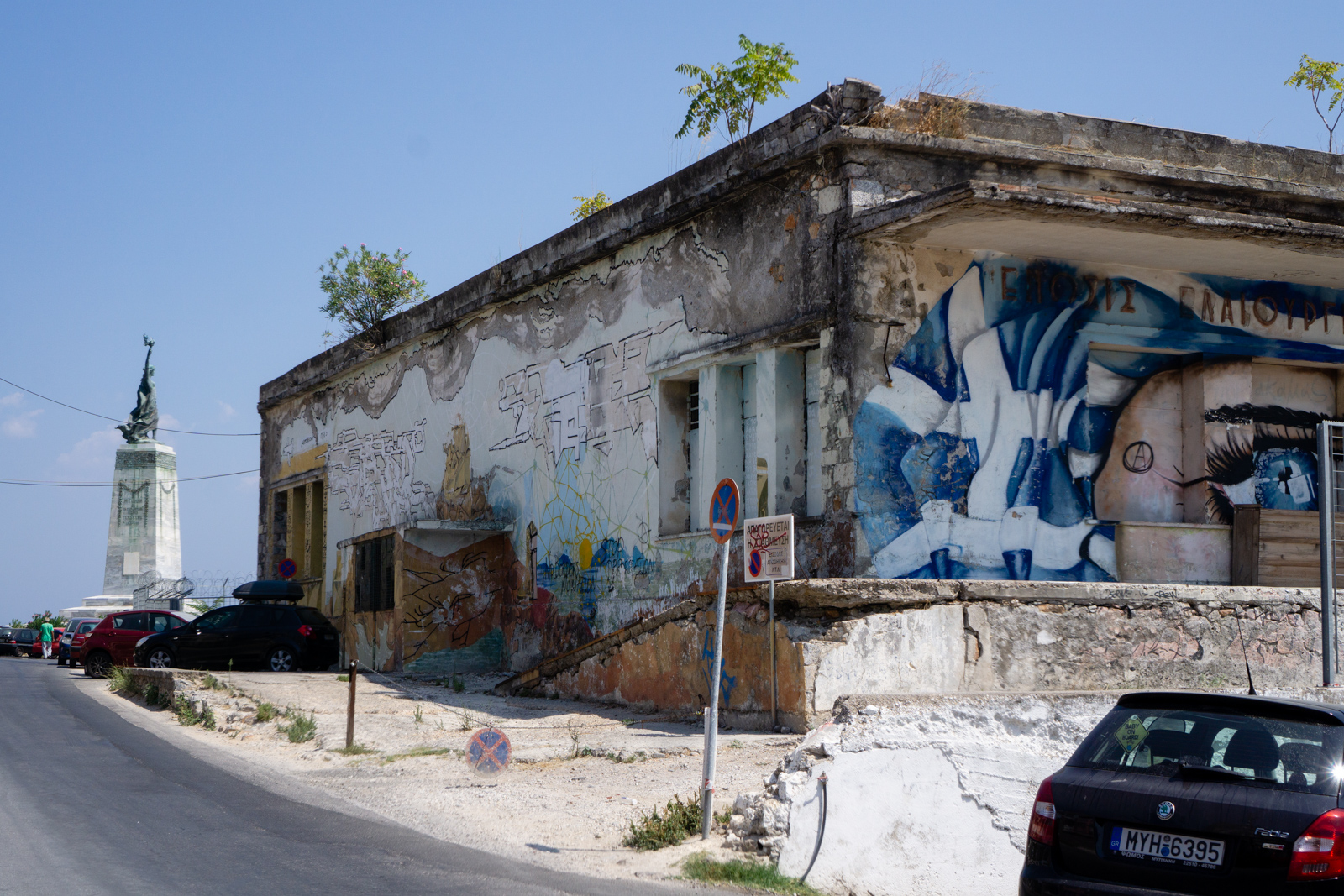
Between Tsamakia Beach and Mytilini Port stands Lesvos’ Statue of Liberty and a graffiti wall depicting a Greek flag around a woman’s head.
©Frida Sterenberg. All Rights Reserved.
When approaching or departing Lesvos by ferryboat, one of the first things one can discern from the topography and the village buildings is a small monument at the shore. It is of a young woman, standing strong and firmly holding a torch. It’s Lesvos’ Statue of Liberty. As its muse, it’s there to welcome newcomers and instill a sense of hope and freedom. The statue was dedicated at this site, between the port of Mytilini and Tsamakia Beach, in 1930. It celebrates the fallen soldiers of the wars between 1912 and 1922. Helma never noticed the statue, though.
Upon returning to the island, just a few days after the transfer to Athens, the family did not have a house to go back to. Their place in Thermi was already occupied by other refugees. A friend, a coordinator at an NGO, let them stay in his place in Mytilini for a few days until they found another option. Days turned into weeks, which turned into months. They are still living at their friend’s house and recently have started to pay him some rent.
“I am [a]shamed,” Helma said on the phone about their housing situation.
Since the end of September, they have been on a bureaucratic roller coaster. After a few days on Lesvos, they returned the keys of the apartment in Athens to the UNHCR office on the island. Because their files were transferred to Athens, they were told they could not get housing anymore. At the end of October, their cash assistance was terminated. They were told their asylum application might be dropped altogether. Their contact with UNHCR assistance is a translator who texts messages back a day after they ask questions, when he does. Helma said they consulted a couple lawyers but because their files were in Athens not much could be done.
“Everywhere we go they tell us we have to go somewhere else,” said Helma in a WhatsApp message. “There are some days my knee has a lot of pain, but I’m so busy that I can’t go to the doctor.”
Her hope was dwindling.
“I don’t know if it’s really a day for me to be able to live comfortably or not,” she wrote, with a troubled emoji at the end.
Although they were welcomed back at their jobs with the NGOs, the income is minimal and not enough for the family to subsist. The three older sisters were looking for additional jobs to increase their self-sufficiency.
In December, things started slowly to improve. Helma found work as a seamstress at Safe Passages, a workshop inside Mosaik Support Center that creates bags with discarded lifejackets found in the beaches of Lesvos.
After four months, UNHCR told them their files will return to Lesvos. Asiye said that only then they will have the possibility to go to Kara Tepe, a smaller refugee camp on Lesvos where mostly families are housed. Cash assistance is being reinstated in mid-January. Their identity cards were renewed for six months but, with new policies in place, their asylum interview can only happen on the mainland. They will need to go to Athens, this time on their own, to have their asylum interview.
“Afghan nationals received positive decisions on their asylum claims in 71.7 percent of cases,” Boris Cheshirkov, of UNHCR Greece, wrote in an email, citing data from the Greek Asylum Service. But their stakes are high. “Afghanistan was the main country of origin in 2019 with 20,364 asylum claims lodged by Afghan nationals by the end of November 2019 in Greece,” he wrote.
If their asylum request is not granted, Helma said, they will look for alternatives to go to another country. They heard from a friend who left, successfully, with a smuggler. The cost to get one person out of Greece with a fake passport, they were told, would be €4,000. At some point they thought of sending Ali (16, boy) and Negin (13, girl) alone in hopes that in the near future they could ask for reunification with their mother because they are minors. The idea is on the backburner because Raziye, their mother, strongly opposes it. And they don’t have the money anyway.
“I think for future, it’s all depend on us, how much we try for our goals. I think we will have a better life. I have hope. Of course, now we don’t have a good situation, but I know, and I believe that life is never the same and we will see there is power of patience and our fights. We fight for a better life. We are healthy and we have each other, we can pass any difficult moment,” Asiye said in an audio message, in her soft tone of voice, on Dec. 6.
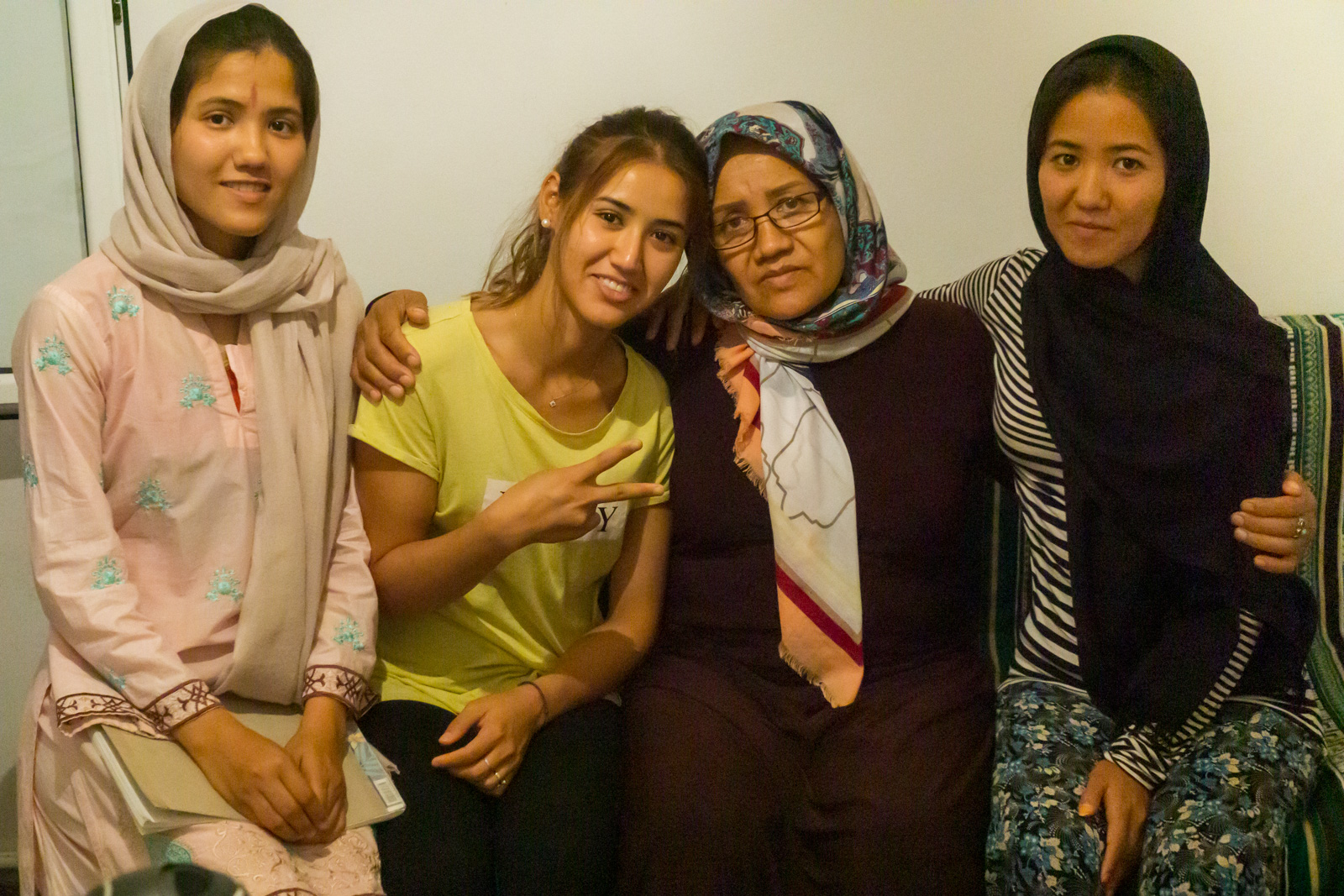
Raziye with three of her children in the place they could briefly call home. Thermi, Lesvos, August 2019. ©Frida Sterenberg. All Rights Reserved.
Raziye’s children were all born and raised in Iran and were always refugees. Under Iranian law, they had no right to acquire citizenship. They have never been to Afghanistan and couldn’t obtain Afghan passports because it was too expensive for them to have to go to Afghanistan to claim them for nine children let alone to renew every time they expired. Raziye and her deceased husband never considered going back to live in Afghanistan. Their extended family also settled in Iran, and they had no property to go back to.
“Because Afghanistan was always [at] war and they don’t have anyone there,” Helma said her mother told her.
Besides the sister with a 10-year-old child now on mainland Greece, the siblings also have a brother, 30, his wife, and a 3-year-old girl still in Iran. The family is trying to save money to help them get out to Europe. A married sister is also in Iran, with two young children. She has no plans to leave the country. Yet another sister and her husband applied for asylum while in Iran and are now in Sweden. Raziye has eight children in total and a daughter from her husband’s previous partner.
Raziye and her husband were originally from Bamiyan but lived in Kabul until 1979.
“When the Russians started to bomb, their house was destroyed, and their uncle died. That night they went to Iran,” said Asiye over the phone, with her mother at her side retelling the story in Farsi.
The couple was initially in Arak and then moved to Qom, near Teheran, where they received asylum.
The father worked in the construction of canals; Raziye was weaving wool carpets at home for a carpet seller who came to collect them when ready. The children went to school and the girls helped their mother with the weaving after doing the homework.
In 2013, their father was diagnosed with cancer. He got sick, hospitalized and died within one year. They had to borrow money to pay for the hospital bills.
“After my father died, we have very difficult situation. The economic situation in Iran was very bad, we were all working in factory [except the two youngest children] and we didn’t make enough for rent and food,” said Asiye in a three-way conversation with Helma.
“And when our father was sick, we borrowed money for hospital. We had to work all the time, no vacation even for Nowruz [the Persian New Year]. We couldn’t go to some cities; it was forbidden for refugees. And we’re not allowed to graduate in some majors.”
“It was very difficult because I was always thinking I cannot go to a good university and get a good job,” said Helma.
“And you could not buy a house or a car with your name. Even if you want to by a SIM card you couldn’t with your name. If you have an Afghan passport you can, but if you’re a refugee you cannot. Two years before we came [to Greece], some banks closed the accounts for refugees, they said you cannot have a cash card. So, it was very hard,” Asiye said.
And then, there was the prospect of being forced into marriage.
“My uncle [father’s brother] was always saying to my mother: ‘You can’t manage your life. I don’t want to help you with money, but I want to marry your girls to my sons,’” said Asiye.
When asked to identify where home is, Asiye reflected for a moment before speaking.
“I was born in Iran, but as the Iranians say, I believe I’m Afghan. My hometown is Afghanistan. The things that make me strong… When I saw the racism of Iranians, making fun of Afghans, [it] made me believe that I should not be Iranian, that I am Afghan and it’s not a shame for me.”
Who are the Hazara?
The Taliban considers the Hazaras infidels, and during their regime in Afghanistan they specifically targeted the Hazara population. After the US-led invasion and Taliban ousting, the Hazaras found space to thrive again. Many of those who fled returned to the country in search of reconstructing their lives, both in rural areas and in and around Kabul.
Now, with the Trump administration’s talks with the Taliban, many Hazaras feel threatened again. They don’t believe in promises that the Taliban will let them be in peace.
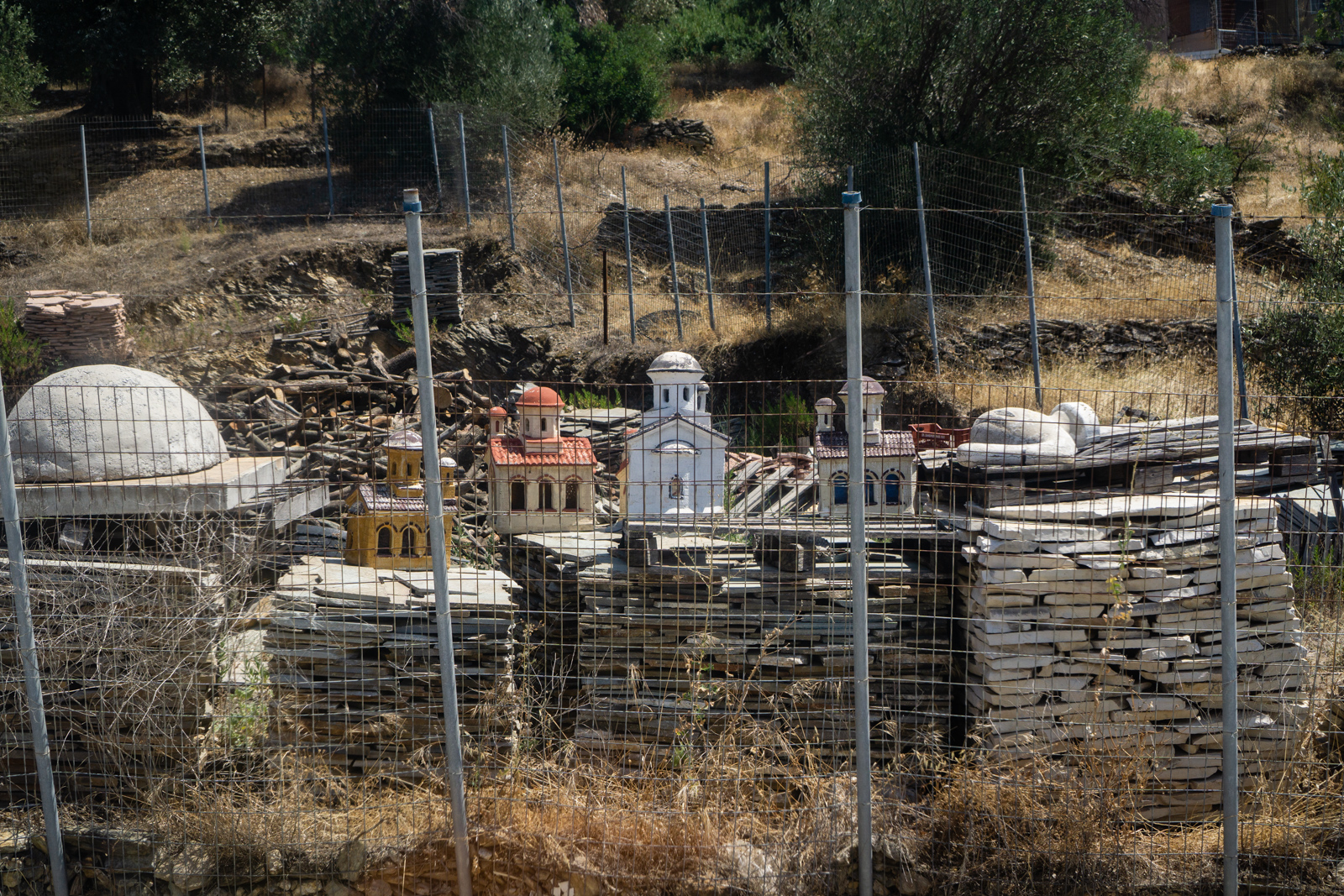
The EU-Turkey Deal
Turkey was to receive more than $6 billion in exchange for patrolling the waters and land and returning to Turkey every migrant, refugee, or asylum seeker attempting to reach the EU from Turkey.
The funds were to help the resettlement of more than 3.7 million refugees in the country, mostly Syrians. Turkey is the country hosting the largest number of refugees in the world. Greece was to keep the existing refugee population contained in the islands until their asylum applications were resolved, and they were transferred to the mainland to continue travel to their destinations or to resettle in Greece. For every refugee returned to Turkey, one Syrian refugee already in Turkey should be sent to an EU country to maintain a balance.
The EU-Turkey Deal, as it became known, was welcomed by the European nations alarmed by the prospects of millions of migrants resettling in those countries and the many more that could still arrive in the future. The deal was opposed by non-governmental agencies who recognized the risks of this containment policy and the potential consequences that could result for the physical well-being and the psychological health of these already traumatized populations. But the idea of keeping a balance between people disembarking and people leaving the islands has never really worked, and the Aegean islands have seen the number of migrants explode and the living conditions of the refugee camps deteriorate dramatically in the last five years.
In November, Turkey’s president Recep Tayyip Erdoğan, dissatisfied with the EU’s reaction to his country’s advance into Kurdish controlled territory to create a buffer zone between Turkey and Syria, and to his plans to move Syrian refugees over there, threatened to release millions of refugees who would then try to reach the borders of Europe.
New Policies in Place
Back in the summer, Efi Latsoudi, part of the team of the NGOs Lesvos Solidarity and Mosaik Support Center, was pessimistic about the situation of refugees on Lesvos.
“We see the political will in Europe is not to make things better, it’s to make things worse for the refugees. So, we try by damaging the lives of these people, and by putting their lives in danger, to protect Europe.”
Latsoudi’s hope rests on non-governmental groups and civil society.
“There is a really strong solidarity movement, there are people that stand in solidarity with refugees all over Europe and in Greece and I believe this can make the difference.”
A local young person's perspective
Most of the work of integration between the new and local communities on the island is done by NGOs. Mosaik Support Center, One Happy Family, Rowing Together, Boat Refugee Foundation are just but a few of the many Greek and international organizations offering essential services to keep asylum seekers on the island fed, clothed, active, engaged, and away, during daytime, from the dismal conditions inside Moria, and of other refugee camps. Some NGOs offer English, Greek and Farsi classes, music classes, libraries. Others offer playgrounds for children, soccer games and entertainment for both young and adults. But the offerings are not enough for a population that doubled in size, just from August to December of 2019.
↓ In August, the Community of Sant’Egidio, an Italian catholic charity group, organized a celebration on Sappho Square, at the center of Mytilini, to remember all the people who died trying to cross the Aegean Sea in search of a safe haven or a better life in Europe. The remembrance ended with a party, with everyone invited to dance. In December, a Pope’s aide went to Lesvos and, with the charity group, brought 33 refugees from Lesvos to Rome, including 14 minors from Cameroon, Afghanistan and Togo.



